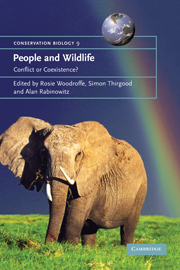Book contents
- Frontmatter
- Contents
- List of contributors
- Foreword
- Acknowledgements
- 1 The impact of human–wildlife conflict on natural systems
- 2 The impact of human–wildlife conflict on human lives and livelihoods
- 3 Characterization and prevention of attacks on humans
- 4 Non-lethal techniques for reducing depredation
- 5 Techniques to reduce crop loss: human and technical dimensions in Africa
- 6 Evaluating lethal control in the management of human–wildlife conflict
- 7 Bearing the costs of human–wildlife conflict: the challenges of compensation schemes
- 8 Increasing the value of wildlife through non-consumptive use? Deconstructing the myths of ecotourism and community-based tourism in the tropics
- 9 Does extractive use provide opportunities to offset conflicts between people and wildlife?
- 10 Zoning as a means of mitigating conflicts with large carnivores: principles and reality
- 11 From conflict to coexistence: a case study of geese and agriculture in Scotland
- 12 Hen harriers and red grouse: the ecology of a conflict
- 13 Understanding and resolving the black-tailed prairie dog conservation challenge
- 14 People and elephants in the Shimba Hills, Kenya
- 15 Safari hunting and conservation on communal land in southern Africa
- 16 Socio-ecological factors shaping local support for wildlife: crop-raiding by elephants and other wildlife in Africa
- 17 Jaguars and livestock: living with the world's third largest cat
- 18 People and predators in Laikipia District, Kenya
- 19 Searching for the coexistence recipe: a case study of conflicts between people and tigers in the Russian Far East
- 20 A tale of two countries: large carnivore depredation and compensation schemes in Sweden and Norway
- 21 Managing wolf–human conflict in the northwestern United States
- 22 Policies for reducing human–wildlife conflict: a Kenya case study
- 23 An ecology-based policy framework for human–tiger coexistence in India
- 24 The future of coexistence: resolving human–wildlife conflicts in a changing world
- References
- Index
10 - Zoning as a means of mitigating conflicts with large carnivores: principles and reality
Published online by Cambridge University Press: 23 November 2009
- Frontmatter
- Contents
- List of contributors
- Foreword
- Acknowledgements
- 1 The impact of human–wildlife conflict on natural systems
- 2 The impact of human–wildlife conflict on human lives and livelihoods
- 3 Characterization and prevention of attacks on humans
- 4 Non-lethal techniques for reducing depredation
- 5 Techniques to reduce crop loss: human and technical dimensions in Africa
- 6 Evaluating lethal control in the management of human–wildlife conflict
- 7 Bearing the costs of human–wildlife conflict: the challenges of compensation schemes
- 8 Increasing the value of wildlife through non-consumptive use? Deconstructing the myths of ecotourism and community-based tourism in the tropics
- 9 Does extractive use provide opportunities to offset conflicts between people and wildlife?
- 10 Zoning as a means of mitigating conflicts with large carnivores: principles and reality
- 11 From conflict to coexistence: a case study of geese and agriculture in Scotland
- 12 Hen harriers and red grouse: the ecology of a conflict
- 13 Understanding and resolving the black-tailed prairie dog conservation challenge
- 14 People and elephants in the Shimba Hills, Kenya
- 15 Safari hunting and conservation on communal land in southern Africa
- 16 Socio-ecological factors shaping local support for wildlife: crop-raiding by elephants and other wildlife in Africa
- 17 Jaguars and livestock: living with the world's third largest cat
- 18 People and predators in Laikipia District, Kenya
- 19 Searching for the coexistence recipe: a case study of conflicts between people and tigers in the Russian Far East
- 20 A tale of two countries: large carnivore depredation and compensation schemes in Sweden and Norway
- 21 Managing wolf–human conflict in the northwestern United States
- 22 Policies for reducing human–wildlife conflict: a Kenya case study
- 23 An ecology-based policy framework for human–tiger coexistence in India
- 24 The future of coexistence: resolving human–wildlife conflicts in a changing world
- References
- Index
Summary
ZONING: A CONCEPTUAL INTRODUCTION
Conflicts in land use are an inevitable consequence of the presently high human population densities living on a planet of finite size. Within this finite space, land use planners struggle to integrate as many potentially conflicting elements as possible using two approaches: the multi-use concept where compatible land uses can occur in the same area, and zoning. Zoning is any form of geographically differentiated land management where different forms of potentially conflicting land use are given priority in different areas. For example, in modern town planning some areas are zoned as residential, others as commercial, industrial, agricultural or recreational. Zoning has been widely used in biodiversity conservation in the creation of national parks, nature reserves and other protected areas. The focus of this chapter is to examine how zoning can be applied to the conservation of large carnivores. This requires balancing the twin goals of conserving viable populations of large carnivores, and minimizing conflicts with humans, which is proving to be an exceptional challenge in our crowded world.
LARGE CARNIVORES AND HUMAN ACTIVITY: CONFLICTS, COMPATIBILITY AND CONTEXT
Conflict
Zoning is only an issue because large carnivores cause conflicts with some human activities and interests throughout the world. These conflicts have been described in detail elsewhere (Woodroffe et al., Chapter 1, Thirgood et al., Chapter 2) but here we shall list the most important conflicts relevant for the discussion on zoning.
- Type
- Chapter
- Information
- People and Wildlife, Conflict or Co-existence? , pp. 162 - 175Publisher: Cambridge University PressPrint publication year: 2005
- 32
- Cited by



